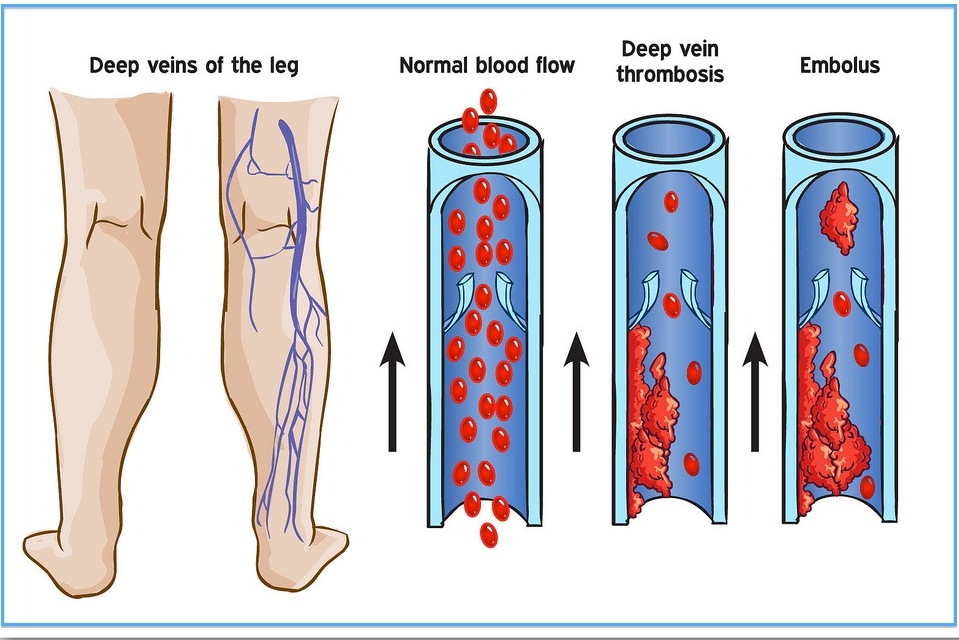What is DVT and why should you care?
Posted: Sunday, March 3, 2013 | Revised: November 14, 2013
March has been designated “DVT Awareness Month.” DVT stands for Deep Vein Thrombosis. It is a condition where a blood clot forms in one of the large veins of the body. This happens most often in the legs, but can occur in the arms or veins in the abdomen or pelvis as well.
DVT can cause complications either in the place where the clot formed or in other parts of the body.
Immediate problems at the site where the clot forms by blocking the blood flow out of the affected limb. Sometimes this causes pain, swelling , and discoloration of the overlying skin. In many cases, however, it may not cause any immediate symptoms at all. This can be even more of a problem, because it allows the DVT to go unrecognized and therefore untreated.
Long term complications in the affected limb are referred to as “Post-thrombotic syndrome.” This develops due to damage to the delicate valves within the vein. These valves normally open to allow the blood to move up toward the heart and are supposed to close to keep the blood from flowing back down toward the ground. When the valves are damaged, there is a long, wide open column of blood putting pressure on the vein wall and stretching the vein out. This can lead to significant long term swelling of the leg, damage to the skin and soft tissues near the ankle, and in severe cases, open sores (venous ulcers) on the lower leg.
Even more dangerous than the complications of DVT in the place where the clot formed is the potential for clot to move to another site. In the first hours to weeks after a clot develops, it has a very soft consistency, almost like jelly. Pieces of this clot can easily break off and float through the circulation. In most cases, these clots become lodged in the lung. This is a condition referred to as “Pulmonary Embolism” or PE. Small pieces of clot can cause chest pain or shortness of breath. Large pieces of clot may block enough of the circulation to the lungs to cause death. People who do survive a PE may have scarring in the lung veins which make it harder for the heart to pump blood through them, leading to congestive heart failure.
All of us begin with a hole between the right and left sides of our heart that is supposed to close at birth or shortly thereafter. In some people, this hole remains open. That becomes a potential route for blood and things travelling in it to cross from the venous side directly over to the arterial side without being filtered through the lungs. When a piece of clot passes through that hole, it can travel to the brain and cause a stroke.

Are you at risk for DVT?
There are a number of well-known risk factors for DVT and PE. Things that greatly increase a person’s risk of developing DVT or PE include:
- Having active cancer. Malignancies increase the production of clotting factors in the blood, making it much easier for the blood to clot.
- Undergoing a surgical procedure. This risk is increased even more if the person having the surgery:
- Has active cancer
- Is obese
- Is undergoing a major orthopedic operation on their hip or knee
- Having an inherited clotting disorder, such as Factor V leiden mutation. If someone in your immediate family has had an unprovoked DVT (i.e., one that didn’t occur after surgery, major trauma, or long travel), you are more likely to have one of these clotting disorders. Blood tests can screen for these.
- Being immobilized for a prolonged period of time. This allows blood to pool in the extremities. When blood isn’t moving, it tends to clot. Situations in this category include stoke or spinal cord injuries, being hospitalized or bedridden, or prolonged travel such as an overseas flight.
- Having had a previous DVT or PE increases your risk. 1/3 of people who have a DVT or PE will have another one within 8 years.
Things that moderately increase the risk of developing DVT or PE include:
- Increasing age. The majority of people who develop DVT are over age 60, but DVT can strike at any age. More than one in five people who have a DVT when they are 60 or older will die within the year.
- Smoking damages blood vessel walls, making it easier for clots to form in them.
- Women who take oral contraceptive pills are at increased risk. Smoking while taking oral contraceptives further increases the risk.
- Trauma, especially including long bone fractures or spinal cord injury
- Varicose Veins
- Congestive Heart Failure
- Respiratory Failure
- Pregnancy
If you fall into any of these categories, talk to your doctor about what you can do to decrease your risk!